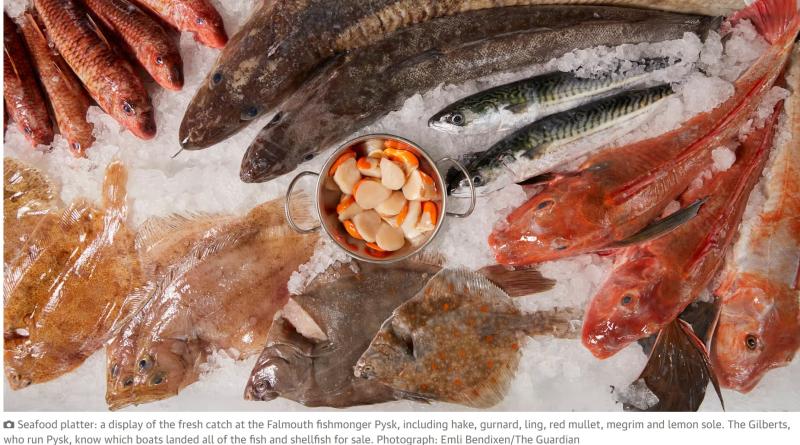Perched on a quay in the Cornish port of Falmouth is Pysk fishmongers, where Giles and Sarah Gilbert started out with a dream to supply locally caught seafood to the town. Their catch comes mainly from small boats that deliver a glittering array of local fish: gleaming red mullets, iridescent mackerels, spotted dabs and bright white scallops, still snapping in their shells.
Occasionally, they will get a treasured haul of local common prawns – stripy, smaller and sweeter than the frozen, imported varieties in UK supermarkets. So, when customers come into the shop asking for prawns, Giles Gilbert presents “these bouncing jack-in-a-boxes” with a flourish, hoping to tempt buyers with the fresh, live shellfish.
“I think most people are absolutely fascinated,” he says. “But they’ll say, ‘Have you got anything a bit bigger than that?’ or, ‘I wanted something that was already cooked.’”
"People are looking for cod or salmon when there’s this immaculate fish that’s been caught maybe an hour ago Giles Gilbert, fishmonger
Time and again, Gilbert finds himself rummaging around in the freezer to retrieve an emergency bag of imported shellfish, lest he lose a loyal customer.
It’s not just prawns. “We have access to some incredible fish, but it stays on the counter because what people are looking for is cod or salmon, when there’s this immaculate fish that’s been caught maybe an hour ago,” he says.
“It’s frustrating when we’ve developed relationships with fishermen and we can’t take their entire catch.”
The UK is perhaps unfairly stereotyped as a nation with an unadventurous palate. But where seafood is concerned, that’s backed up by the data. There are more than 300 species in the UK’s coastal waters, and British people eat strikingly little of it.
According to Seafish, the UK public body supporting the industry, the UK’s “big five” – cod, pollack, salmon, tuna and prawns – comprise 62% of seafood consumed in Britain (though the Marine Stewardship Council names the big five as cod, haddock, salmon, tuna and prawns, and reckons they make up 80% of fish and seafood eaten in the UK when consumption outside the home, in restaurants and in fish ‘n’ chip shops is included).
Most of what is eaten in the UK is imported, while the majority of what is fished in British waters is sent elsewhere.
It’s not just the UK. In the European Union, cod, pollack, salmon, tuna and prawns account for 44% of consumption. In the US, as well as these five, the 10 most popular species include tilapia, clams and catfish, accounting for 76% of seafood.
Our global eating patterns increasingly tend towards fewer and larger species, consumed further from where they are caught.
Those dietary choices fuel problems such as overfishing, resource-intensive fish farms, higher greenhouse-gas emissions, and tonnes of fish waste. The percentage of populations fished at biologically unsustainable levels is increasing worldwide, according to a recent UN report, while our appetite for seafood is also likely to grow.
The picture appears bleak – and yet, if selected and consumed carefully, seafood provides a powerful opportunity to improve the environmental impact of our diets overall.
“Seafood can be, and in some situations is being, produced very sustainably, especially when compared to other terrestrial animal-source foods,” says Jessica Gephart, an expert in the globalisation of aquatic food at the University of Washington.
What’s on our plates – and why?
So, can we shift our diehard eating habits towards new fish? And why do we prefer cod over cockles, and salmon rather than sole? It’s a complex global picture, starting with the UK, where people once ate a wider variety of seafood, including an abundance of sprats, herring and whelks. Essex University led research published last year that offered clues about why these patterns have changed.
From the early 1900s, industrialised fishing fuelled the expansion of British boats beyond inshore waters into plentiful northern seas, where they began scooping up several hundreds of thousands tonnes of haddock and cod. Cue the spread of fish ’n’ chip shops, which found a convenient vehicle for their batter in these large, filleted and less bony fish.
After 1973, when the UK joined the European Economic Community, British boats lost access to more distant fishing grounds and became confined to inshore waters, where those big white fish were less abundant. But by this point, the national preference for haddock and cod was entrenched, and the UK began importing these species to fill the deficit.
“So the situation we’re in today is that we import a lot of the seafood that we consume, including those ‘big five’ species, and we export most of what we land,” says Luke Harrison, who led the Essex University study. In fact, between 1975 and 2019, the share of British fish consumed by the UK public dropped from 89% to 40%, his research showed.
Our palates have also been dulled by how we shop. Jack Clarke, seafood engagement manager at the Marine Conservation Society (MCS), says: “The homogenisation of our diet, especially around seafood, is probably due to our over-reliance on supermarkets.”
Big chains need to secure large and consistent supplies of easily processable seafood, which usually creates a bias towards a smaller number of fish from bigger species that are caught by larger fisheries, he says. This could increase pressure on wild stocks or push retailers towards species raised in fish farms.
The simplifying effect of our globalised food system is most obvious in wealthy countries. Anna Sturrock, an aquatic ecologist at Essex University, and a co-author of the study, says: “We can afford these imports. That’s probably the main reason it hasn’t changed: we’ve got a taste for it, and it’s always been available to us.”
That is echoed in the US, where prawns make up more than 30% of Americans’ annual consumption of seafood. About 90% are imported from countries such as Indonesia and India, where the farming of prawns has been implicated in labour abuses and the destruction of mangroves. Yet US-caught prawns met half of the national demand in the 1980s.
Even as one of the top six seafood producers worldwide, the US imports about 65% of what it consumes. “US seafood consumption is dominated by a few species,” says Gephart. “A significant share of that also comes from canned and processed forms, like frozen breaded patties.”
Research by Seafish shows that convenience is a key driver of consumer choices in Britain, and our impoverished palates as a result may help explain why we have lost our taste for kippers and turn up our noses at the mussels that are abundant off UK shores.
David Willer, at Cambridge University, has researched underexploited seafood, such as mussels. “We’ve done lots of research on that, and it’s mostly down to convenience and ease of preparation, and a kind of ‘yuck’ factor,” he says.
In India, another top global producer of fish, tropical waters support a great diversity of species, but in lower quantities. As Divya Karnad, a marine geographer and conservationist at Ashoka University, near Delhi, explains, that means a fisher who catches 100 local fish is likely to have several dozen species in his net.
“Historically, coastal India had ways of dealing with this, either by having recipes specifically for different fish, or having a generic recipe in which they could add many species,” she says.
But with an increasingly urbanised population in India, she adds: “People don’t have enough time to handle their food. So instead of cleaning hundreds of small fish, if you can get a fillet then you will choose that.”
Karnad’s research has drawn a link between this more selective diet and overfishing. Picture that fisherman hauling in his catch of 100 diverse fish, she says. “But now, he’s able to sell only 15. So he has to go out that many more times to actually make up the cost.”
She also believes there is an aspirational quality attached to some fish species, such as Norwegian salmon, which is now in demand among wealthy people. This fish is now ubiquitous globally, says Shakuntala Haraksingh Thilsted, director for nutrition, health and food security impact area plarform at CGIAR, the world’s largest global agricultural innovation network.
Thilsted, the 2021 recipient of the World Food Prize, found salmon on sale even in the diverse seafood markets of Thailand. Japan did not use salmon in sushi a few decades ago but now it’s everywhere, she says, swaddled in blankets of sticky rice.
“That has something to do with the power of the private market – that foods that are considered desirable, aspirational, have moved across borders,” Thilsted says.
What should be on our plates?
How do we begin to disentangle these patterns to eat more sustainably? There is no magic bullet for something as complicated as seafood, says Sturrock at Essex University, adding: “When we think about sustainability, it’s not just about overfishing, it’s also about how far we bring it from different places, and the impact of that fishery, or the aquaculture type, on the local environment.”
There is also the issue of fish waste as well as social factors – labour rights, fishers’ livelihoods – embedded in our choice of fish.
And there are trade-offs. A local, small-scale fishery may still be putting pressure on a delicate population, while a more distant fishery might have higher carbon emissions but be exploiting a more stable population.
Even farmed salmon, with all its problems, is not so clearcut when emissions from its production are lower than those associated with chicken, and improvements in breeding and feed are bringing those emissions down further, says Gephart, at the University of Washington. This can make sustainable eating feel like a game of Whac-A-Mole. “It is really hard and unreasonable to put that on consumers,” she says.
Governments do need to make better decisions about where and what is fished, and how to support fishers to work more sustainably in a difficult industry. However, “that doesn’t mean that we should throw up our hands and say that ‘seafood is bad, it’s all too complicated’,” Gephart says.
“It’s about how we signal our values for sustainable production, so that we can lean on industry and governments.”
Clarke, at the MCS, suggests getting guidance on what populations are green-rated, or to find alternatives, from sources such as its own Good Fish Guide or Seafood Watch, produced by the US not-for-profit organisation Monterey Bay Aquarium.
For instance, for those wanting a change from salmon, which makes up almost a third of all fish eaten in the UK, farmed trout has fewer pollution issues and also uses less fish in the feed, Clarke says. “And they’re really tasty, with a similar flavour profile to salmon, and just as simple to cook.”
If you live close to a fishmonger, tap into their knowledge too, he adds. They will also have a more diverse array of fish than most supermarkets.
“If we make room for diverse foods on the plate, then we will be getting closer to the goals we aspire to,” says Thilsted. Eating a wider variety of fish takes pressure off certain populations, and shift our diets towards smaller species that are green-rated, such as herrings and sardines, which can be eaten whole, thereby helping tackle fish waste.
It also shifts the spotlight on to shellfish and bivalves such as mussels. If there is one seafood with almost universal environmental credibility, this is it, says Gephart, whose research shows that of all aquatic foods, farmed mussels and seaweeds have the lowest environmental impact. Together, they can create refuges for ocean species, while mussels also have protein levels similar to beef.
The challenge now is increasing consumer demand, says Willer, at Cambridge University. He is working with the food industry on innovative projects to make mussels, for instance, more palatable to the British public.
Others are taking the more futuristic leap into lab-grown seafood to relieve pressure on overfished populations. Meanwhile, others are working to build sustainability across the wider industry. In India, Karnad set up InSeason Fish, which works with restaurants to raise awareness of fish to avoid and to promote alternatives, depending on the region and month.
“We realised that in culinary institutes in India, chefs were not being trained with indigenous ingredients. They were instead learning about French cuisine,” says Karnad, whose organisation trains chefs in how to prepare India’s diverse fish. It has also brought in local fishers directly to advise chefs on the incoming catch and procure what they need.
In another attempt to diversify menus, a British company called CH&Co, which caters for venues including schools, hospices, and offices, is focused on reducing the use of the big five. They provide their clients with data about the proportion of big five species that they are buying, and then take steps to educate and challenge their culinary teams to reduce the use of these fish.
As a result, “chefs are putting more diverse species at the centre of menus and working to change customer attitudes to what fish species should appear on a plate”, says Clare Clark, the head of sustainability at CH&Co.
The changing face of sustainable seafood has provided new ways to “vote with your wallet”, says Jack Clarke, adding: “It really does have an effect.”
In Cornwall, Gilbert is seeing people doing exactly that. In a recent experiment, he displayed three types of scallops on his fish counter, each with the catch method and sustainability information supplied alongside the price. To his surprise, he found customers preferred the most expensive but sustainable hand-dived scallops.
He may not have won them over on the local prawns yet. But he senses that the tide is turning: “We just seem to have more and more interest in what we’re doing here.”





